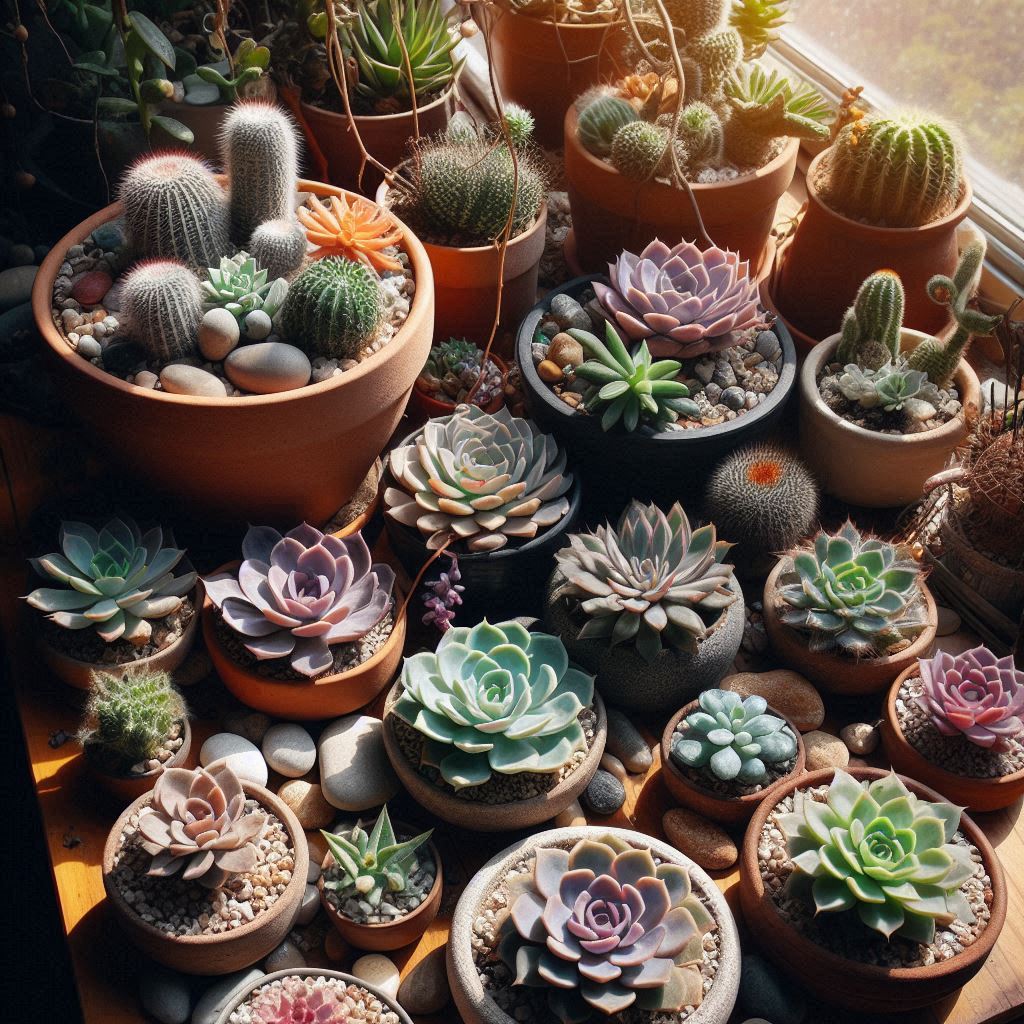Do succulents like direct sunlight? This is a common question among plant enthusiasts looking to keep their green friends healthy. Succulents are unique plants known for their ability to thrive in dry environments, but understanding their light needs can be essential for successful growth. Let’s delve into how much sunlight these resilient plants truly need, and how to create the perfect conditions based on their natural habitats. Whether you’re growing them indoors or outdoors, mastering their light requirements is key to ensuring vibrant, healthy succulents.
How Much Direct Sunlight Do Succulents Really Need?
Many succulent enthusiasts wonder, “Do succulents like direct sunlight?” The answer depends largely on the specific type of succulent. Generally, succulents do appreciate sunlight, but the intensity, duration, and timing can be crucial for their health.
Most succulents originate from desert environments where they receive plenty of sunlight. However, not all succulents are created equal. Some varieties prefer morning sunlight rather than the harsh afternoon rays. It’s important to know your succulent’s natural habitat to ensure optimal growth.
When introducing succulents to direct sunlight, it’s wise to do so gradually. This gradual acclimation helps prevent sunburn, which can manifest as bleached patches or brown spots on the leaves. Sunburn can be quite damaging, especially for young or sensitive plants.
To keep your succulents thriving, periodically check the leaves for signs of too much sun exposure. Indicators such as yellowing or wilting can suggest that your succulent might need a little more shade. Conversely, if your plant is looking elongated or ‘leggy,’ it could mean it’s not getting enough light.
Balancing the light conditions is key to healthy, vigorous succulents. Consider investing in light meters or simply observe your plants closely to determine their preference. Remember, the goal is to mimic their native environment as closely as possible.
In the end, while most succulents do enjoy a good sunbath, understanding their specific needs will ensure they grow lush and beautiful. Finding the right balance between direct sunlight and shaded periods is essential to nurturing thriving succulents.
Signs Your Succulent Is Getting Too Much Sun
Succulents, while resilient, can suffer from overexposure to sunlight. Watch for discoloration; leaves turning brown or red often indicate sun stress. A tell-tale sign is scorch marks or burnt leaf tips, which occur when a succulent becomes sunburned, similar to skin exposure in intense sunlight.
Additionally, check for shriveling; a dehydrated and sun-damaged plant may have wrinkled leaves. In extreme cases, succulents can develop black spots or see-through leaves, signalling cell damage from the sun.
Another indicator is leaf drop. Plants might shed leaves as a defense mechanism to reduce sun exposure and conserve water. Also, observe for signs of slow growth or stunted appearance as succulents in stress may halt development.
To protect your succulent, monitor its position relative to windows or outdoor environments. Moving a sunburned succulent to a partly shaded area can help, preventing further damage while allowing recovery time to adjust to new light conditions. Regularly check moisture levels to avoid dehydration, keeping the plant thriving even with abundant light exposure.
Best Succulent Varieties for Full Sun Exposure
Understanding Sun-loving Succulents
When it comes to selecting the perfect sun-loving succulents, it’s essential to choose varieties that thrive under intense sunlight. Some species are naturally adapted to hot, dry environments and can flourish in spots that get full sun exposure for most of the day. These hardy plants not only survive but can dazzle with vibrant colors and unique shapes.
Top Sun-loving Succulent Varieties
Some of the best choices for full sun exposure include Agave, known for its sharp leaves and impressive size, Echeveria, with its beautiful rosette form that comes in various colors, and Sedum, renowned for its versatility and resilience. Other excellent options are the Sempervivum or ‘Hens and Chicks’, Aloe which also offers healing properties, and the stunning Pachyphytum.
Each of these succulents has unique characteristics making them ideal for sunny spots. For example, Agave is drought-tolerant and can grow quite large, while Echeveria enjoys well-drained soil and can change color under different sun conditions. Sedum is perfect for ground cover or hanging baskets, providing a burst of color.
Maximizing Sun Exposure
To ensure your succulents thrive, place them in areas with direct sunlight, ideally southern or western-facing spots for the most intense and prolonged exposure. Rotate your pots to allow even sun exposure and prevent any part of the plant from getting scorched.
Ensure the soil is well-draining to prevent root rot, a common issue if they receive too much water in such sunny conditions. Mulching with rocks or pebbles can keep the soil moisture levels balanced while enhancing root health.
Nurture Your Sun-loving Succulents Tailoring care to the specific needs of these varieties can yield breathtaking results. Regular checks for sunburn signs and careful acclimation periods when moving them outdoors can prevent damage. These practices empower your succulents to maintain their remarkable aesthetics.
How Direct Sunlight Impacts Succulent Growth
Direct sunlight plays a vital role in the growth and health of succulents, but understanding its impact is crucial to ensure these plants thrive. Succulents have evolved to store water in their leaves, allowing them to withstand hot, arid environments where direct sunlight is plentiful. However, it’s essential to consider the extent and duration of sunlight they receive to prevent potential damage.
Exposure to adequate sunlight can enhance the vivid colors in succulents’ leaves, such as reds, purples, and pinks, improving their overall appearance. This pigmentation is a natural response to sunlight, providing a protective barricade against the sun’s intense rays.
However, too much direct sunlight, particularly during the hottest parts of the day, can cause succulents to experience sunburn. This results in discolored spots on leaves, which are a clear indicator that your plant is receiving excessive light exposure.
On the other hand, the lack of direct sunlight can cause succulents to become leggy, losing their compact structure and resulting in elongated stems as they stretch towards the light source.
By managing sunlight exposure and providing a balanced amount of light, you can ensure that your succulents receive the benefits of sunlight without the associated risks. Pay close attention to the environment and adjust their placement accordingly to optimize their growth and health.
Do All Succulents Thrive in Direct Sunlight?
While many succulents indeed enjoy a sunny spot, not all thrive under direct sunlight. Understanding the specific light needs of your succulent species is crucial to its health and vitality. Some varieties, like Echeveria and Crassula, generally require bright light but can be sensitive to intense, direct rays.
Succulents have evolved to cope with various levels of sunlight, thanks to their natural habitats ranging from deserts to wooded areas. Adaptation is key—some succulents develop vibrant colors under full sun, while others can become sunburnt and stressed.
It’s essential to understand that not all succulents are created equal, which means you should research your plant’s specific needs. For instance, succulents like Aeonium may prefer partial shade, especially in hotter climates.
Monitoring Light Levels
Monitor your succulents for signs of overexposure to sunlight, such as browning or white patches on the leaves. On the other hand, if leaves become too elongated and pale, your plant might need more light. Readjust as needed to ensure optimal growth.
Experiment by offering filtered light or moving plants gradually into brighter areas to prevent shock. By slowly adjusting their light conditions, you can prevent sun damage and optimize their appearance.
Creating the Ideal Environment
Regardless of your succulent’s light preference, ensure it has adequate soil drainage and receives water when needed. A balance of light and care results in a thriving, robust succulent.
Shading Tips: Protecting Succulents from Sunburn
Protecting succulents from sunburn is crucial for their health and longevity. Succulents, with their thick, fleshy leaves, are often mistaken as desert plants that thrive under intense sunlight. However, too much direct sun can lead to sunburn, causing irreversible damage to their leaves. It’s essential to know the right amount of sunlight your succulents need.
One effective way to protect these plants is by providing them with adequate shading during the hottest parts of the day. Using sheer curtains, shade cloths, or even placing them under the indirect cover of taller plants can moderate the sunlight they receive. This helps in maintaining the balance of light exposure and offers protection against harsh UV rays.
Pay attention to your succulent’s location. Placing them on a windowsill with a filter, like a light curtain, can still allow them to bask in the necessary light without the risk of overheating or burning. For outdoor succulents, consider rotating their placement according to the sun’s movement. Observing your plant’s behavior is key; watch for any changes in leaf color or texture, as these could be signs of too much sun.
Always remember, succulents need time to adjust to new lighting conditions. If relocating them to a sunnier spot, do so gradually to prevent shock. Not all succulents require the same amount of sunlight, so research the specific needs of your plant species for optimal results.
Indoor Succulents: How to Ensure They Get Enough Light
Bright light is crucial for indoor succulents to thrive, but ensuring they receive the right amount of it can be tricky. When placed indoors, position your succulents near east or south-facing windows, as these usually provide ample light without being too harsh. If your home lacks brightly lit spots, consider using artificial grow lights designed specifically for indoor plants. They’re a valuable tool to supplement natural sunlight.
Monitor the color and growth patterns of your succulents to gauge their light needs. A plant that stretches or grows «leggy» is often a sign of inadequate lighting. Conversely, vibrant colors and compact shapes usually indicate sufficient light exposure.
To ensure optimal lighting throughout the year, periodically rotate your plants. This helps succulents receive even light on all sides, preventing uneven growth.
Finally, be mindful during seasonal changes. As the days become shorter, indoors may get less natural light, making it necessary to adjust your light strategy. With careful attention, your indoor succulents will stay healthy and attractive.
What Happens If Succulents Don’t Get Enough Sunlight?
Succulents are well-known for their durability and ability to thrive in a range of environmental conditions; however, insufficient sunlight can lead to various issues. Many succulents, requiring ample light, can suffer if their sunlight needs are not met. First, it’s important to recognize that succulents adapt to the desert’s bright and sunny conditions. When deprived of adequate sunlight, these plants may start to exhibit specific signs.
A significant indicator of insufficient sunlight is etiolated growth. Succulents will begin to stretch towards the light source, creating leggy and elongated stems. This not only affects their aesthetic appeal but also compromises their structural integrity. Leaves may become widely spaced, altering the plant’s natural compact appearance.
In addition to changes in physical structure, succulents deprived of sunlight can experience color fading. The vibrant hues typically seen in healthy plants may dull, as pigments that develop under intense light lessen in shaded environments. This shift in coloration often suggests the plant is not receiving enough direct light to produce the pigments responsible for its usual brightness.
Another consequence of inadequate light is poor growth. Succulents rely on sunlight for photosynthesis, the process through which they convert light energy into chemical energy. Without sufficient light, their growth will slow, resulting in smaller leaves, thinner stems, and an overall less vigorous plant. This can lead to weakened health and vulnerability to diseases or pests.
Ensuring your succulents get enough sunlight is essential for maintaining their health and appearance. Consider positioning them near bright, sunny windows if they are indoors. When kept outside, choose a location where they can bask in the morning sun while being protected during the hottest part of the day. Understanding the nuances of light exposure will help ensure your succulents remain strong and beautiful.
Adjusting Light Exposure: When to Move Succulents into the Shade
It’s essential to understand when succulents need a break from the intense rays of the sun. While many succulents are sun-lovers, too much direct sunlight can cause them to suffer from sunburn, which appears as brown spots on their leaves. Knowing when to move your plants to shadier areas can prevent these issues from occurring.
Observation is key. Pay attention to the color and texture of your succulents. If their vibrant colors start to fade or if you notice any signs of browning, it might be time to adjust their light exposure. Succulents have a remarkable way of communicating their needs if you know what to look for. For instance, leaves that become wrinkly or start to curl could indicate that they’re losing too much moisture, a sign of excessive sun exposure.
During particularly hot months, consider placing a shade cloth over your succulents during peak sun hours. Alternatively, moving them to a spot that receives filtered light can help. Many succulent enthusiasts use porches or curtained windows indoors, which simulate the partial shade found in their native environments.
Shifting succulents to the shade isn’t only a summer task. Depending on your region, transitional periods like spring and fall also require adjustments. As the earth tilts during these seasons, sunlight intensity changes, and your succulents’ needs may shift accordingly.
Remember, while some succulents prefer a full sun bath, others thrive better with a mix of sun and shade. It’s all about finding the perfect balance that suits the specific needs of each succulent variety. Always do a bit of research to understand the unique light requirements of the succulents you are nurturing.
How to Avoid Sun Damage on Succulent Leaves

Succulent plants are adapted to storing water in their leaves, stems, and roots, making them extremely hardy and sun-loving. However, it’s essential to provide the right balance of sunlight to prevent sun damage. Providing sufficient yet controlled exposure to sunlight helps maintain their vibrant colors and healthy growth.
Firstly, acclimatization is crucial. If you recently bought a succulent or moved it outdoors, gradually increase its sunlight exposure over a few weeks. Starting with indirect sunlight and slowly moving to direct sunlight helps prevent sudden sunburn.
Another method is to use shading techniques during peak sunlight hours, especially in summer. Covering plants with a light cloth or moving them to a shaded spot during the midday sun can prevent scorching. Monitoring for signs of sun damage, like brown or burned spots on leaves, is essential to adjust their placement quickly.
It’s also important to note that not all succulents thrive in the same sunlight conditions. Some species prefer partial shade, especially those that originated in shadier habitats. Understanding your succulent’s native environment can guide proper light exposure.
In conclusion, while succulents appreciate abundant sunlight, giving them too much too quickly can lead to leaf damage or other stress signs. Proper balance, gradual exposure, and protective measures keep succulents healthy and robust.
Partial Sun vs. Direct Sun: What’s Best for Succulents?
Suculentas são plantas fascinantes que são frequentemente adaptadas para condições áridas. Ao discutir a diferença entre sol parcial e luz solar direta, é crucial compreender as necessidades específicas dessas plantas. Suculentas prosperam em climas que espelham seus habitats naturais, onde frequentemente recebem luz solar intensa. No entanto, a quantidade de luz ideal pode variar dependendo da espécie e do ambiente.
Ao comparar o sol parcial com a luz solar direta, é importante considerar a intensidade da luz que sua suculenta receberá. Sol direto significa exposição sem obstrução à luz solar, geralmente por mais de seis horas por dia. As suculentas que têm folhas mais espessas tendem a tolerar essas condições melhor. Pode ser preciso fornecer algum tipo de sombreamento se a luz direta estiver muito intensa para evitar queimaduras nas folhas.
Por outro lado, luz solar parcial refere-se a áreas onde a suculenta recebe luz filtrada ou desprotegida por um período menor, cerca de duas a quatro horas de luz solar direta. Algumas variedades, principalmente aquelas com folhas finas ou mais verdes, podem preferir essas condições, pois a exposição solar intensa pode ser demasiado.
Acerte no equilíbrio adequado de luz para garantir que suas plantas permaneçam saudáveis, exibindo cores vibrantes e crescendo robustamente!
Esteja atento aos sinais de estresse solar e faça os ajustes necessários para otimizar as condições de luz para suas suculentas.
How to Gradually Acclimate Succulents to Direct Sunlight
Gradually introducing succulents to direct sunlight is essential to prevent shock and sunburn, ensuring their thriving health. Succulents are sturdier than many houseplants but still require careful acclimation to increased light levels.
Begin by exposing succulents to morning sunlight, which is gentler than the intense afternoon rays. Place them in a spot where they receive direct sunlight for only 1-2 hours in the early day. Gradually extend the duration by 30 minutes every few days, allowing them to adjust incrementally.
Pace and Patience are key. Over several weeks, this gradual increase will help succulents toughen up without stress. Monitor them closely for signs of sun damage, such as scorched leaves or bleached coloring. If any signs appear, reduce exposure time immediately.
Protect and Adjust
using temporary shade solutions like a sheer curtain or moving them under a larger plant when the sun is too intense. Consider rotating the plants to ensure even light distribution and avoid uneven growth.
For particularly sensitive varieties or those with lighter leaves, the process should be even slower. This allows them to gradually build resilience and adapt to stronger light conditions without adverse effects.
Overall, the goal is to ensure succulents receive the optimal amount of sunlight to thrive, without overwhelming them. Maintaining a balance with gradual acclimation contributes to healthier and more robust plants in the long run.
Direct sunlight plays a crucial role in the health and growth of succulents. However, not all succulents are the same. Understanding how much light your specific succulent needs is essential. Some succulents, especially those from arid deserts, thrive under direct sun exposure. Others might prefer more shaded environments. Recognizing these differences can help you provide an ideal atmosphere for your succulent to flourish.
Observe your succulent’s appearance to determine if it is receiving the appropriate amount of sunlight. Too much direct sunlight can lead to sunburn, resulting in discolored or scorched leaves. Conversely, insufficient sunlight might cause your plant to stretch as it seeks more light, affecting its natural shape.
Start by exposing your succulent to morning sun, which is less intense than afternoon sunlight, and watch how it reacts. Providing a gradual increase in sunlight exposure can prevent shock and promote healthy adaptation to brighter environments. If your succulent starts showing signs of stress, like paling leaves, consider relocating it to a less sunny spot.
Ensuring your succulent receives the right balance between sun and shade can make all the difference in its vitality and aesthetic appeal.







